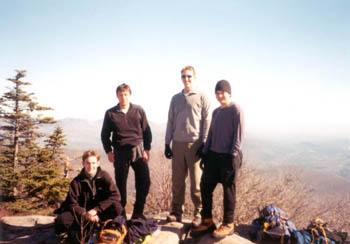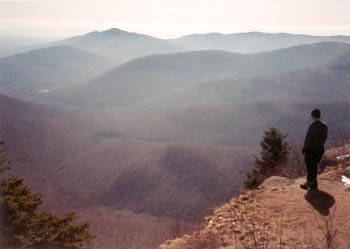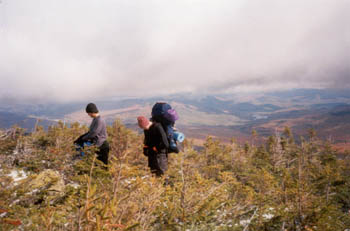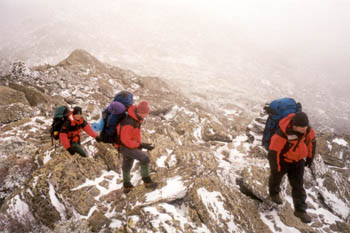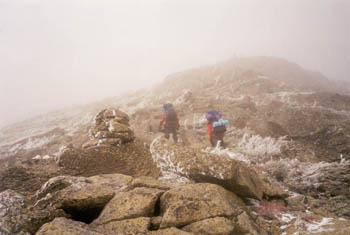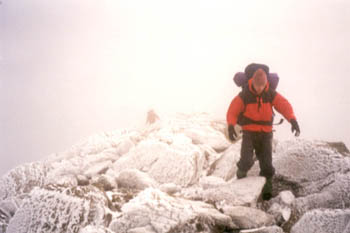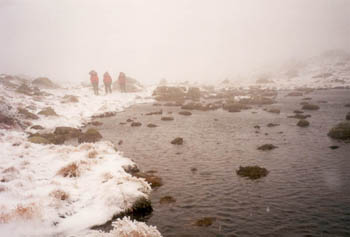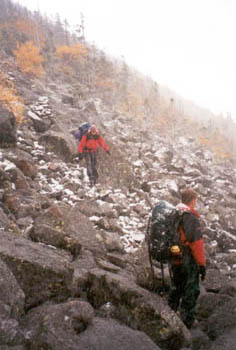On several weekends each semester I managed to get out of town and go hiking in the Adirondacks, or the White Mountains, or the Catskills.
I also went paddling, and climbing, from time to time. Here are the notes and photos:
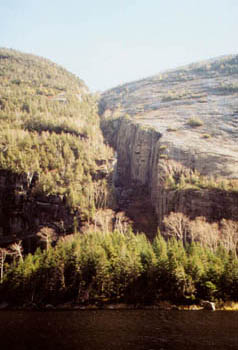
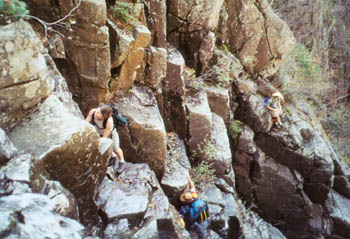
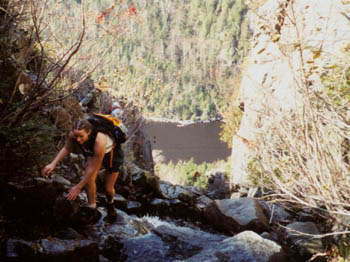
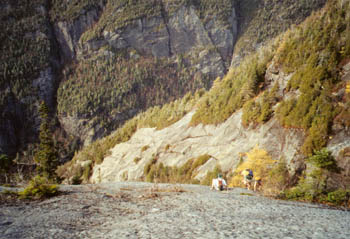
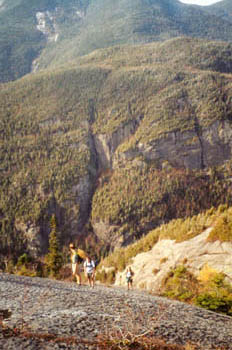
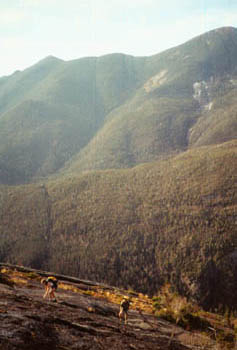
Temperatures were in the 70s and skies were clear - so what better thing to do on an October Saturday than climb Mt. Colden by the challenging Trap Dike route? The third highest peak in New York, Colden lies just north of Mt. Marcy, the highest peak, and south of Algonquin, the second highest. There are a number of marked trails to the summit but we chose a route following the steep rocky cleft in the granite known as Trap Dike. Rising sharply from the clear waters of Avalanche Lake, the cleft becomes choked with brush a thousand feet below the mountain summit and hikers commonly exit to the granite slab alongside for the remainder of the hike. While Trap Dike is easily climbed in fair weather, the stream running through it makes climbing slippery and wet in places. The slab above is usually dry in the summer months but when present, water presents a problem because the slab must be friction climbed.
The six of us arrived at the South Meadows trailhead at 10:30am and set out along a gently sloping path to Avalanche Lake. The going was easy until we reached the lake; there the trail wound through immense boulders, over wooden ladders, and along planks bolted the the rock face where it dropped straight to the water. The long narrow lake was bounded on both sides by vertical granite faces rising several hundred feet before angling back to mountain summits. We rounded the lake and then left the trail to thread our way through thick spruce underbrush to the base of Trap Dike.
1500 vertical feet of climbing the steep wet rock occupied us for the better part of the afternoon, including a half-hour stop to assist two hikers turning back and build a snowman from icy drifts sheltered in shaded hollows. After completing the crux in rushing water that soaked our feet and made climbing difficult, we exited at a break in the high rock walls that had confined us. The slab, cratered from the action of ice and sun, was easy to climb despite the water running down it in places from melting snow. Algonquin Peak towered above us even as we cimbed higher, but Avalanche Lake below had disappeared from sight. Our arrival at the summit was a surprise to a group that had climbed by a different route - it was uncommon to see hikers appear from the steep and seemingly impassible granite slopes.
We descended via a more gently sloping but unbelievably muddy trail, walking the last three miles on the dirt path in darkness and arriving at the car at 7:30pm. Temperatures had dropped but were still quite pleasant. Back in Troy too soon, I immediately began to plan a climbing trip for the next day and another hike for the next weekend.
That was Climbing Trap Dike, Adirondacks, October 2001. ~Mike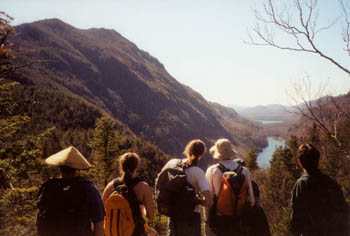
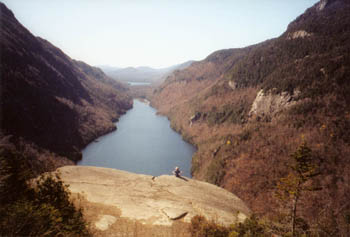
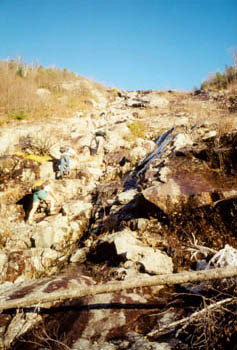
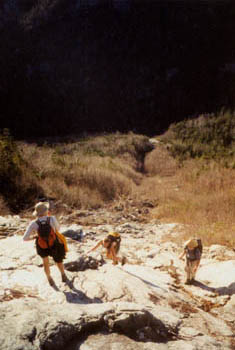
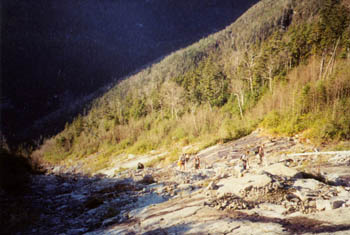
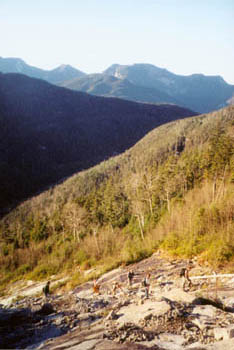
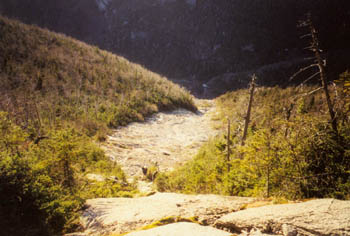
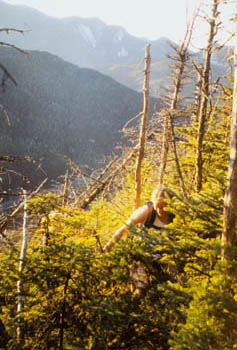
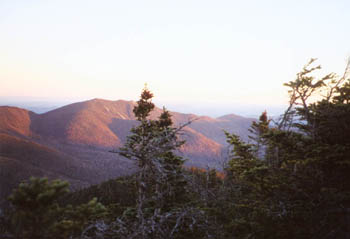
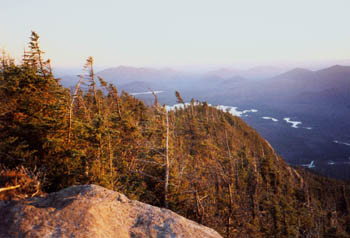
It was Sunday morning. Skies were clear and temperatures were rising quickly from a crisp 40 degrees as we set out onto the well traveled route north on US 87 to Keene Valley, in the heart of the Adirondack High Peaks. We made a quick stop at The Mountaineer to admire shiny new gear and then drove back to the St. Huberts trailhead. After three miles of easy walking along a dirt road we took a trail to Indian Head and the Fish Hawk Cliffs, where we stopped to take in the spectacular view and relax in the sunshine. As we still had several thousand feet of climbing to do, we descended to the valley floor, left the trail, and set off thrashing through thick spruce scrub.
Ice covered the stream running through the gully we followed, but the ground was not yet frozen and we sank ankle deep in mud from time to time. We made our way down the gully for a quarter mile before angling up the slope through equally dense spruce forest. At great length we came to a point from which we could see the slide and correct our course. We arrived at the slide nearly a third of the way up and began to climb on the treeless rock, but our enthusiasm was soon damped by dense thickets of brush that disagreed with our intentions to move through them. By this time the sun was getting low in the sky so we hurried up the rock face, taking care not to slip or knock stones loose. There was a surprising amount of ice still on the rock after a day of warm weather.
At the top of the slide we climbed a steep section of rock and then made our way through a tangled spruce tunnel to the summit just as the sun was setting. The treetops were touched with an orange glow that also illuminated mountains to the east. The sun sank below the horizon within a few minutes of our arrival, treating us to a beautiful sunset behind Mt. Marcy and the rest of the Great Range. As the last alpenglow faded from the peaks around us, the cold set in and we hurried to pack up and get off the mountain, very much aware of the rapidly falling darkness. The trail down was steep and covered with ice but it was on the west face so it remained faintly illuminated by the glow of the sunset. This vanished as we dipped below the ridge and neared the valley floor.
Traveling a rough trail by dark is an interesting experience - one can follow by feel more than by sight, seeking the hard packed earth. Faint differences in the darkness signaled rocks and trees, but ledges and boulders leapt up unexpectedly. I led without a light, finding it much easier to sense the trail than be blinded by the bright white light I carried. We did the second half of the trail in near-total darkness, counting off from time to time to make sure all were still present. A spectacular display of stars had appeared in the sky above but with no moon there was little light in the forest and I found it challenging to stay on the trail. The final three miles to our vehicle were on smooth dirt road, paved with white sand that shone brightly and was much easier to follow than the rough muddy trail had been. We arrived back in Troy sixteen hours after leaving that morning, later than expected but well worth the mountaintop sunset and hike out under the dark starry sky.
That was Climbing the Nippletop Slide, Adirondacks, October 2001. ~Mike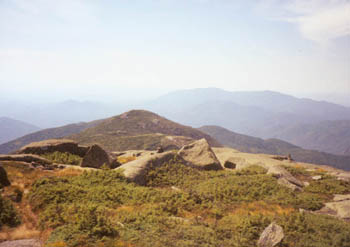
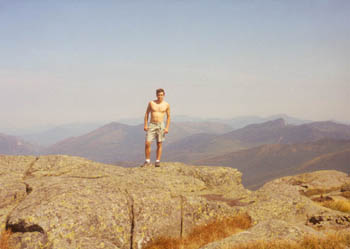
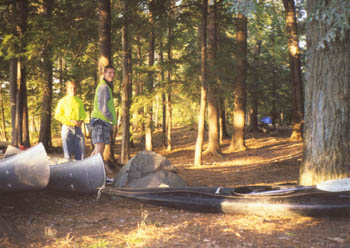
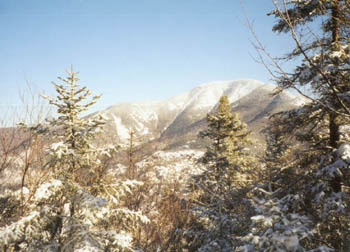
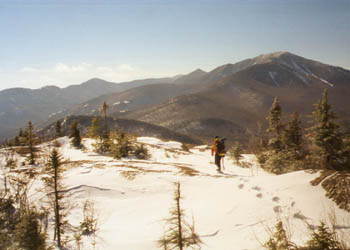
Three of us went north to the High Peaks early one sunny Saturday in February, packs filled with snacks and warm clothing. The air temperature was in the teens at the trailhead. Despite our early start we were not the first to break trail through the six inches of freshly fallen powder in the valley. This proved to be helpful; the going was easy even as we ascended and the snow deepened. When the going got particularly steep we donned our snowshoes to make use of the improved grip and continued up the well packed path through a foot of powder.
As we climbed higher the snow got steadily deeper. From time to time we came onto clear slides from which we enjoyed spectacular views of Giant Mountain to the East. At one of these overlooks the hikers who had arrived ahead of us had apparently tired of breaking through eighteen inches of powder and had turned back; that explained the well packed trail. Entirely in my element, I bounded on ahead in the deep powder, making my way up steep gullies where an ice axe would have helped and eventually arriving with the other two on the windswept summit. We took off our snowshoes on the rocks and I set off with my camera to take some photos. But the instant I stepped off the rock onto the seemingly thin wind-blown snowcover, I sank to my waist and after a few steps floundered back to the rock for my snowshoes. The wind had sculpted drifts into beautiful shapes around the boulders and spruce thickets.
The cloudless sky offered clear views in all directions - the higher peaks towering around us, all blanketed in fresh snowfall. The sun was already past its zenith and sinking fast, so we soon set out to the northwest to descend by a different route. Trail markers normally at eye level were at waist height and many were missing. We shuffle-stepped down snow slopes and through tunnels in the evergreens, at length reaching a well-traveled trail leading many miles back to the trailhead. A low sun accompanied our return to the car. After signing out we headed into Keene Valley for sandwiches at the Noonmark Diner. The place was frequented by other hikers as well as curious travelers passing through who eyed our hefty boots and goretex with some admiration.
That was Climbing Round Mountain, Adirondacks, December 2001. ~Mike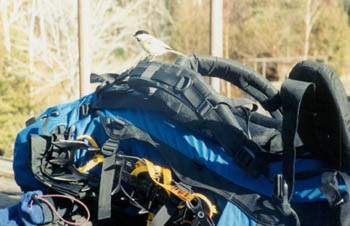
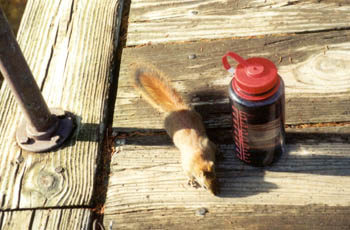
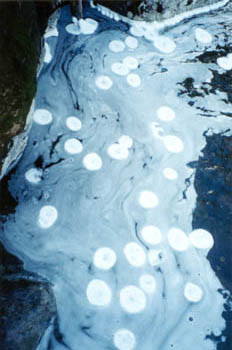
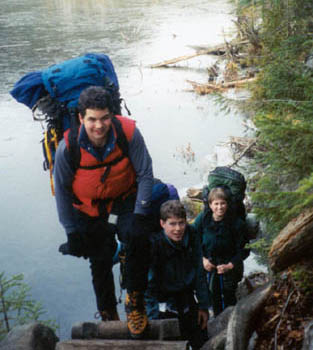
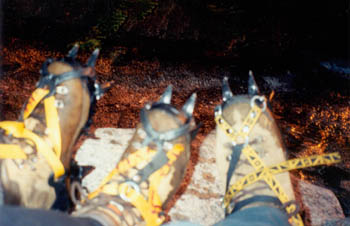
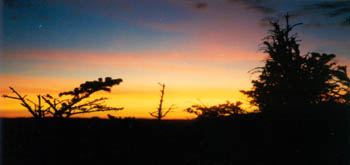
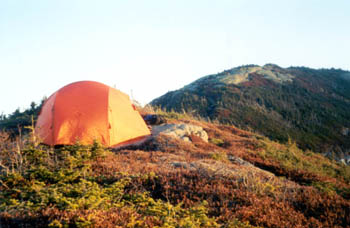
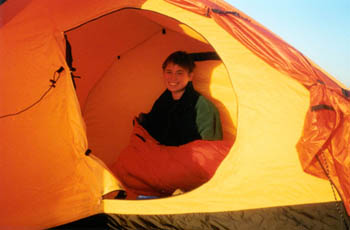
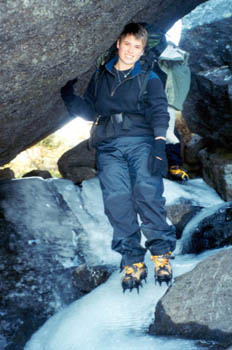
Jeremy's Tercel handled the four of us and our four packs quite well on the way to and from the ADK Loj. We hiked in Saturday through Avalanche Pass to the summit of Colden, via Lake Colden. The weather was beautiful - sunny and cool - and the ground remained frozen through the day, keeping the mud on the ground where it belongs. The snow had all melted but we used crampons to climb the icy trail. Sheets of ice flowed down the trail and glittered in the light of the low sun. We watched the sun set over Algonquin Peak in a glow of red and gold, and then scrambled onto the summit ridge as the sky behind us turned brilliant colors and the tiny sliver of moon overhead began to shine. Jeremy and Mike found a place for their tent near the summit and Erin and I made camp a short distance down the ridge, on a windy granite slab. My new tent happily sheltered us from the gusts while we cooked up a delicious meal of calzones. The stars were brilliant and clear when we fell asleep. I awoke at 2am and looked outside to watch for meteors but, seeing none and finding it very chilly, I went back to sleep and woke up just before daylight to see a few more falling stars and then a beautiful sunrise over Mt. Marcy. The tent became instantly warm in the sunshine, and we took our time cooking hot cocoa and oatmeal and enjoying the beautiful view outside the tent door.
That was the story of a meteor shower hidden by sleep and a nice hike in the Adirondacks. Fall 2002. ~Mike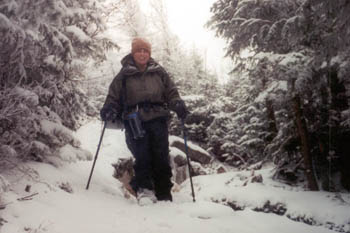
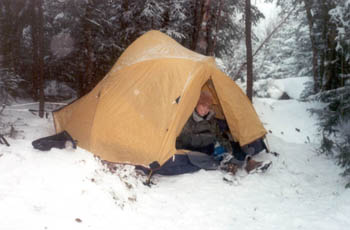
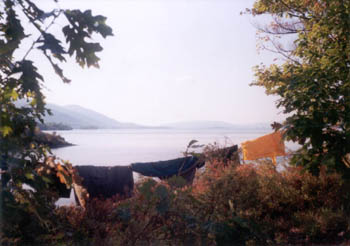
Seeking snow once again in our impatience for winter, Erin and I found three inches of powder along with a half inch of rime ice covering every tree and rock on the upper slopes of Dix Mountain. From time to time, bursts of sunshine illuminated the frozen mountain with a sudden blinding glare but moments later we would be swallowed up by clouds. The summit was obscured when we arrived and the wind was quite strong so we quickly retreated to the shelter of the trees, descended 1500 feet to what appeared to be the only semi-flat tent-sized area on the upper slopes of the mountain, and set up camp. Inside the tent the climate was much warmer, especially once we got dinner cooking in the vestibule. Bedtime was at 7:00 for 12 hours of sleep before sunrise, and then in the morning there was a thousand foot long jump/slide/glissade back to the snow line, followed by an uneventful hike out under clear skies.
That was a weekend in the Adirondacks, October 2001. ~Mike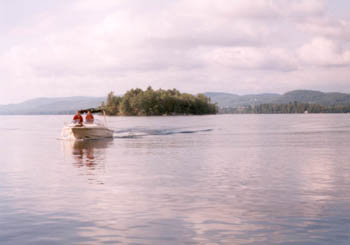
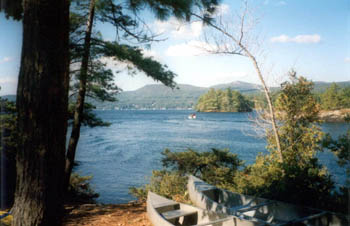
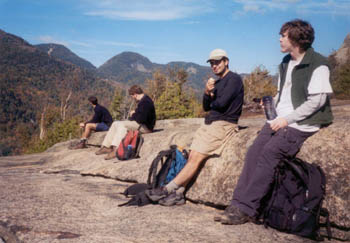
Saturday I took an Outing Club trip to the Adirondacks with primary objectives of snoozing in the sunshine and admiring the beautiful foliage. The location I chose was Indian Head and Fish Hawk Cliffs. Between Gothics and Nippletop, with the Ausable Lakes below and rugged mountain terrain on all sides, the warm sunny cliffs were a very pleasant place to be. We walked in for two hours, lounged on the rocks for another hour, and made our way back to Troy late in the afternoon. If only every day was so nice...
That was a day hike in the Adirondacks, October 2002. ~Mike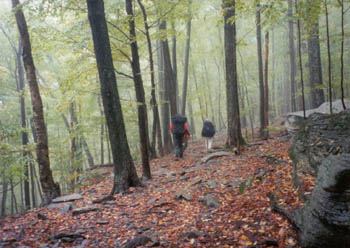
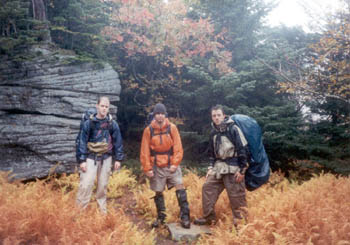
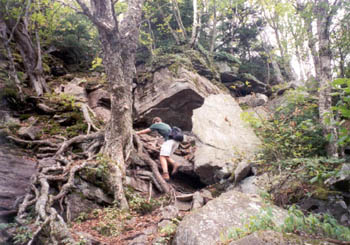
I and my three hiking companions set out for an overnight in the Slide Mtn. Wilderness in the Catskill Mountains, just outside the busy tourist hamlet of Woodstock. In spite of the steady rain we were looking forward to the weekend. A half hour at the market was enough to supply us with a variety of delectable foods, which I repacked in plastic bags as we zoomed down I87 with the windshield wipers on high.
The trailhead was awash but the rain light. We unintentionally found a shortcut to the ridgetop and blazed a new route up the East slope of Panther Mountain. Unsure of where we were once we regained the trail, we holed up in a beautiful little clearing at 3700 feet, unfortunately above the altitude limit for campers. The campsite at the ridgetop was very pretty. Golden ferns filled a small clearing in the fir trees, beside a rocky ledge that sheltered us from the wind. We pitched two tents and retreated inside mid-afternoon, passing the time until dinner. It was dark by 7pm and soon afterward we were asleep.
It continued to drizzle and rain all night but the tent stayed dry. When we emerged in the morning, 18 hours after we first climbed into the tents, each of us had a story in the morning about the rock, hump, root, or hole we were sleeping on or in but we all had sept well, warm, and dry. Outside it was still the same timeless gray misty wet wilderness it had been the day before. We cooked breakfast in the vestibule of my tent, packed up, and hiked down the trail. Water ran over our boots and soon everything that had been the slightest bit dry was thoroughly soaked. Six miles later we emerged dripping and piled into Mike's car, which promptly fogged up. Windows open, heat turned up, we drove out of the rainstorm to dryer places. Apparenly it was only raining in the Catskills that weekend and most other places just had a couple of short rainstorms.
That was a hike in the Catskills, October 2002. ~Mike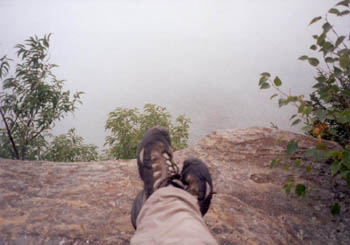
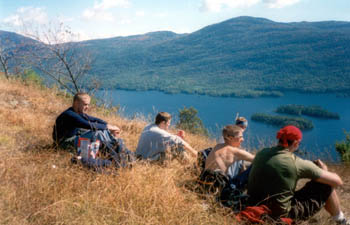
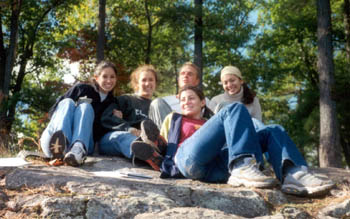
Saturday I led a hiking trip to the Catskills. We drove through the quaint little town of Woodstock, which appears to have frozen in time back in the 60s, and continued through Phonecia to Mt. Tremper, passing the entrance to the Tibetan Buddhist monastery that is the center of the North American faith. I'd like to go see the monastery sometime, or else just go to Tibet. We took a long no-outlet road into Woodland Valley and parked at a convenient trailhead; I had no trail information and only some 1980 topo maps with no marked trails. The weather was absolutely beautiful. We hiked in about 2.5 hours, first on bare ground and then on snow and ice above 3500 feet. We were surprised at the summit to come out onto a spectacular overlook to the East. The rocks were warm, the grassy clearing dry, and the sky clear blue. We took off our crampons and boots and spent an hour relaxing in the sun, the descended the icy trail and returned to Troy. I think I'll be going to the Catskills much more frequently - they are nearly devoid of people in comparison with the Adirondacks, closer, and absolutely quiet. And the geology is different - there are many more flat places we might camp.
That was a hike in the Catskills, winter 2002. ~MikeThe Rensselaer Outing Club has an annual migration to Lake George on the last weekend of September. Not all club members make it; some succumb to RPI homework, others to pressing commitments elsewhere, others to apathy evident from various sad stories, but the strong beat natural selection and make their way to beautiful Turtle Island by any craft that can float and be propelled across water. From schools across the Northeast, other outing clubs send delegations that arrive throughout the night. Heavy rains from the remnants of a hurricane battered us as we paddled to our muddy camps. People drifted in all night long, some arriving by the powerboats, others by canoe and kayak. At times the only indication for the unfamiliar of which way to paddle to the island was our 3-kilowatt light bulb sign blazing the letters ROC into the foggy blackness, staying lit somehow despite the rain. I didn't want to bother with bringing a tent, so in the early morning hours I went to sleep under my canoe and was very comfortable and dry. I woke at 6:30am and tumbled out into a beautiful clear calm morning. Greg and I picked up the wreckage from the stormy night and set out breakfast for the sleepy campers who had begun to drift in. Throughout the day everyone ate, slept, swam, paddled, hiked, dove, jumped, climbed, and found every imaginable source of entertainment. In the evening we fired up the coals and produced hundreds of pounds of grilled meat to feed the island. Then, just after dark, the dancing began. Our fiddler, guitarist, and square dance caller seemed to feel a little out of place playing tunes under a maple tree beside a lake, a distant generator powering amps and lights, and 200 energetic college students romping about in their best attempts at dancing. Fortunately, Mount Holyoke and Lehigh provided extra women to counteract the skewed ratio induced by RPI, MIT, and the other engineering schools in attendance. Rensselaer worker bees stepped out from time to time to tend the hot cider operations, check the power situation, and ensure that their carefully planned operation was going smoothly. Afterwards, some of us went out to the rocks by the lake for stargazing beside lapping waves or shared stories around campfires. I reluctantly retreated to my comfortable accommodations after several hours watching meteors and napped for a short while before rising early again to arrange breakfast and start the long process of packing up the island and sending it back to shore. The work never ends, it seems, with each night for a week before and after calling for some amount of time tending plans and equipment, but just one evening of dining and dancing and quiet hours by the lake is more than enough reward.
That was Fall Lake George, September 2002. ~Mike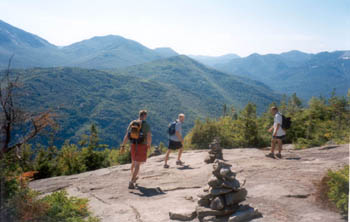
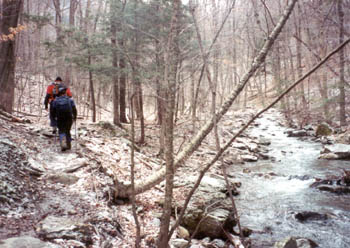
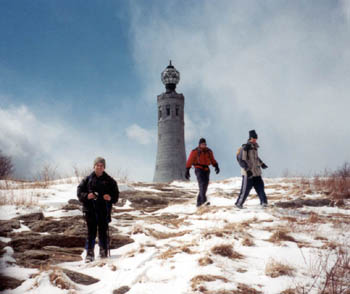
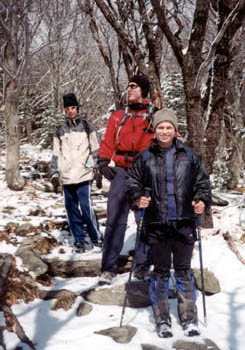
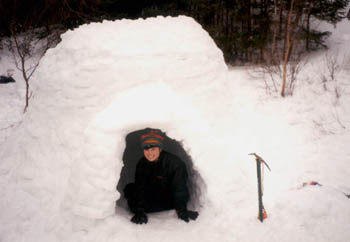
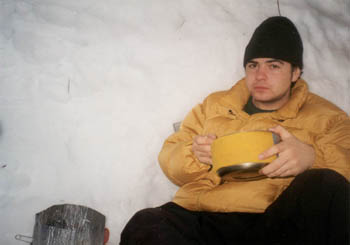
Saturday morning found me rolling northward with three other RPI backpackers headed for the White Mountains of New Hampshire. The night before a massive cold front had collided with unseasonably warm, humid air over the mountains and conditions were quite unstable. We parked at Pinkham Notch under partly sunny skies and watched clouds come roaring over the ridge. Fall foliage was at its peak and very colorful; the drive up through Vermont and New Hampshire had been beautiful. Fallen leaves covered the trail. As darkness fell we made camp at a sheltered location above the Great Gulf. All night the wind roared overhead and rain and ice battered the tents but we remained warm and dry. Morning sunshine revealed snow covering the trees a thousand feet higher on the mountain. We continued up the trail and climbed on the East shoulder of Madison. Colorful forest gave way to dense spruce thickets that gradually thinned out until we were hiking on wind-swept alpine tundra. Rime ice and snow covered every rock and shrub. Spectacular views of the ridge and the valley appeared from the clouds from time to time and the sun shone intermittently. As we neared the summit of Madison the wind began to gust heavily and we hurried over the top to shelter below on the saddle. There it began snowing heavily. After a short lunch break we dropped down into the Gulf via the Buttress trail, passing beautiful Star Lake and then scrambling over vast snow-covered boulder slopes. We camped in light snow at about 3000 feet and, after a quick meal, retreated to our tents as quickly as possible. The arrival of dawn came with much confusion as we pondered the unusual darkness of the tents until I shook off the four inches of snow that had fallen overnight. It was still snowing so we packed up and left without cooking. The snow thinned as we descended but it persisted in sheltered locations in the valleys. Back in Troy hours later under sunny skies with not a hint of snow, I covered my dorm room with wet gear and set aside upcoming weekends for more hikes in the White Mountains.
That was a weekend trip to New Hampshire, October 2002. ~Mike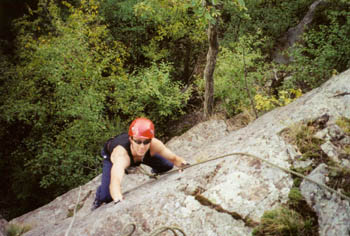
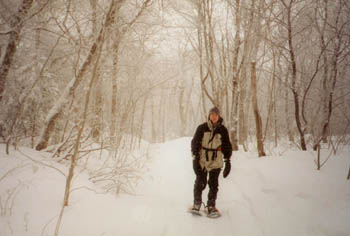
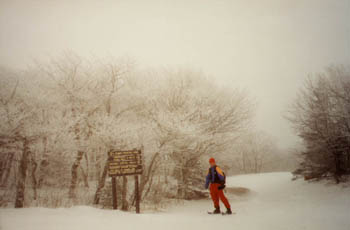
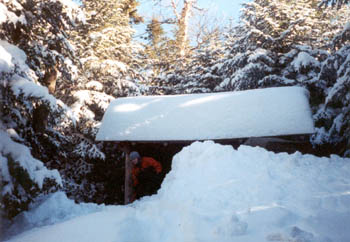
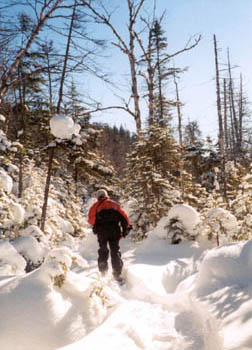
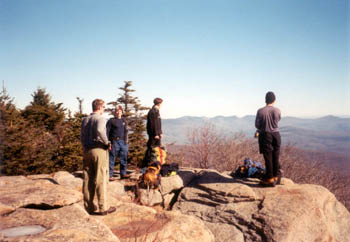
We had no class Monday, so I and fellow hiker Liam went to the Adirondacks very early Saturday morning. My thermometer registered one degree below zero Fahrenheit at the Upper Works trailhead in a remote lead mining area at the west side of the High Peaks region. A group of seven from Cornell, out for a map and compass class, had broken five miles of trail the evening before so we proceeded quickly to a log shelter beside Panther Mountain. Where the trail had not been broken, we sunk knee deep on our snowshoes. Spruce traps swallowed entire snowshoes, sometimes dropping us waist deep without warning. We set up our tent outside the small shelter and then went exploring to find Panther Brook, which would lead us to the top of trailless Panther Mountain the following day. From there we hoped to continue across the ridge to Couchsacraga and Santanoni. But hiking up the steep gully with its thin ice and many waterfalls, in waist deep snow, was difficult and we ran into trouble before we had made much progress. The binding of Liam's borrowed outdoors club snowshoe shattered as he pulled the shoe out of a hole. I lashed it together and we retreated to camp, where I fashioned a usable binding from a small metal grill, parachute cord, and spare webbing straps. The rig worked better on my boot, so I hiked out on it the next morning. It's too bad we didn't get to climb, because the trees were covered in ice up high and very pretty, but it was also nice to be back in the warm apartment with a chance to catch up on work.
That was a winter weekend in January 2003. ~Mike